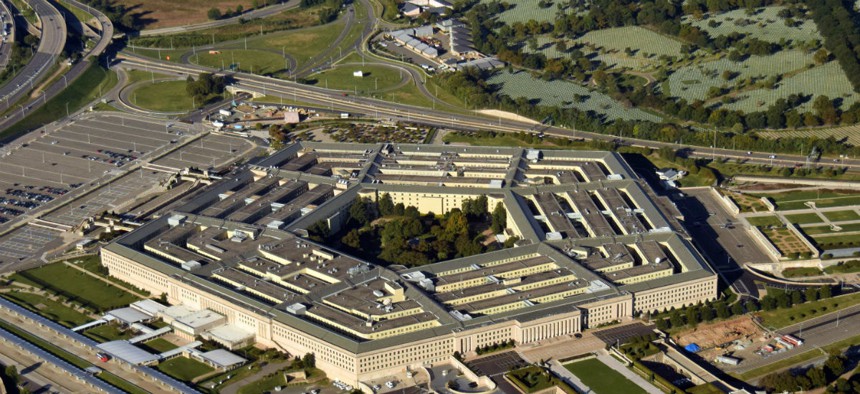
By Ivan Cholakov / Shutterstock.com
Pentagon Delivers Installment on Plan to Streamline Business Operations
Main goals are accelerating hiring and curbing duplication, as Congress mandated.
Operating without a chief management officer, the Defense Department on April 26 released its “Initial Plan” for creating new efficiencies and boosting performance in its hiring, contracting and supply chain operations as required under the fiscal 2019 National Defense Authorization Act.
Though actually due on Feb. 1, the preliminary plan containing goals and timetables is a run-up to the full plan—with mandated cost estimates—that is due on Jan. 1, 2020. The unsigned document was prepared by the Office of the Chief Management Officer, currently headed on an acting basis by Deputy Chief Management Officer Lisa Hershman, who took over after John Gibson’s abrupt departure last November.
“Reforming our business processes to include simplifying hiring; improving employee performance management and engagement; and creating an agile workforce, will enable the department to allocate resources to increase effectiveness and improve military readiness,” said the progress report on the strategic vision for the future of the department’s 700,000 civilian federal employees. “Business reform goes beyond efficiencies and reductions; it includes improving business processes, systems or policies, to improve innovation or processes for weapon system acquisition; and better alignment of resources to support the National Defense Strategy.”
The chief management office has created “reform teams” focused on the NDAA-specified areas of civilian resources management, logistics management, services contracting and real estate management. Under the timetables charted in the report, the Pentagon’s shared services offices—the so-called “Fourth Estate”—are expected to be reduced by some 25 percent as savings are identified and solutions put in place in the areas of hiring, regulation and human resources delivery.
The expected financial savings will be monitored by a “validation process supported by the Undersecretary of Defense (comptroller) and the Office of Cost Assessment and Program Evaluation. The comptroller job is held by David Norquist, who is currently acting as deputy secretary to acting Defense Secretary Patrick Shanahan.
The plan sets out to reduce average hiring time from 100 days to 85, and reduce the delays in recruitment that cause managers to substitute “more expensive military or contractor personnel in place of less costly federal employees.” The objectives—to be measured by performance metrics—are to improve customer satisfaction and improve the match of “enterprise needs to employee competencies in support of mission readiness.”
So far, the hiring reforms have been researched using existing internal resources, the report said, but fiscal 2019-2020 plans may require as much as $500,000 for studies, as well as new legislation.
To improve buying by the world’s largest purchasing entity, the plan would “capture enterprise data and develop business intelligence/analytics that will drive consolidation decisions across services and agencies” to reduce overhead. That will require collaboration between the Defense Logistics Agency and the military services while benchmarking prices against industry. A sample goal: “use economies of scale to save the services upwards of 10% in [the] next two years.”
If cost savings fall short, or cause disruption, the Pentagon will alert Congress by Oct. 1, 2019, the report said.
In concert with the Office of Management and Budget’s ongoing pursuit of new opportunities for interagency sharing of services through “category management,” the chief management office’s team for supply chain and logistics reform “is developing a cross-agency contract and category management procurement methodology aimed at driving efficiencies and savings throughout the DoD,” the report said. “These efforts grew out of the successful Services Requirements Review Board reviews conducted by the Office of the Secretary of Defense and [the Defense Finance and Accounting Services] that resulted in millions of dollars in programmed savings.”
Reforms of contracting and use of category management “will also help the department achieve enterprise business operations consistent with guidance for budget review as it moves from a budget-spend centric acquisition process to a strategic-spend centric acquisition process,” the report added. A key example: application of category management to improve management of the Pentagon’s massive inventory of real property, through “lease process standardization, footprint consolidation, space utilization [and] contract optimization.”
Having kicked off in August 2018, the category management initiative will review the annual $200 billion spend for goods and services, at a pace of “sprints” of $20 billion per quarter for 33 months.
Alan Chvotkin, executive vice president and counsel of the 400-company contractor group the Professional Services Council, characterized the plan as a good start. “Hiring has been a long-standing challenge, and the department has any number of special authorities to hire contracting folks, acquisition folks and cybersecurity folks,” he told Government Executive. “So it’s right to take a look holistically across the department’s needs and try to develop a plan for how to address the workforce needs.”
The new document is a reflection of the early phases, he said, and addresses what is being done at the Office of the Chief Management Officer. “But a lot comes under the responsibility of the military services departments, the defense agencies, and the Office of the Secretary of Defense. So they have some real work ahead.”







